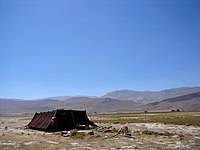
Photo from wikipedia
Alpine land use is possibly as old as human presence in mountain foothills and forelands. Hunting and pasturing have influenced alpine vegetation in temperate zone mountains for at least 6000… Click to show full abstract
Alpine land use is possibly as old as human presence in mountain foothills and forelands. Hunting and pasturing have influenced alpine vegetation in temperate zone mountains for at least 6000 years (Gilck and Poschlod 2019). Today, pastures are one of the fundamental components of the landscape of the Alps and represent agroecosystems with high naturalistic, economic and cultural values. The origin of alpine pastures has been mainly due to productive purposes. For centuries, mountain animal husbandry and pasture feeding have provided highquality dairy products, thanks to the high biodiversity of plant species found in mountain pastures, which gives the product a high nutritional and organoleptic value (Collomb et al. 2008). The quality of these products is also influenced by the welfare of the livestock, which is largely due to their freedom of movement and the ability to choose a ‘natural’ diet through freegrazing management (Villalba et al. 2015). Today, the use of alpine pastures also exerts a crucial role in handing down culture and traditions of mountain communities and in preserving and promoting historical infrastructure (Battaglini et al. 2014). Pastures have also gained a tourism significance since they have made aesthetically attractive mountain landscapes easily accessible and usable for hiking and other sport practices (Pachoud et al. 2020; Schirpke et al. 2016). Other important ecosystem services carried out by pastures are related to the environment. Through their work, farmers actively contribute to the maintenance of a usable landscape, biodiversity conservation and soil protection. Proper herd management and optimal grazing pressure are essential to meet livestock food demands, maintain healthy grass cover, and prevent soil degradation (Baronti et al. 2022). Soil conservation is crucial to preserve ecosystem services such as biomass production, carbon sequestration, and water retention capacity. Effective pastoral system management promotes plant biodiversity (Yuan et al. 2016) and supports other organisms, safeguarding wildlife habitats and providing food for herbivorous animals. Additionally, pastures mitigate natural hazards by serving as open spaces that play a crucial role in fighting forest fires, particularly in resinous forests. Unfortunately, in the last century, as a result of the depopulation of mountain regions, pasture-based systems have suffered severe abandonment (Battaglini et al. 2014). The abandonment and low grazing pressure of a pasture lead to a progressive ecological succession (Cislaghi et al. 2019), favouring the spread of undemanding herbaceous species of low foraging value (such as Nardus stricta) and, when pastures are below the forest line, the recolonization of tree and shrub species (such as Larix decidua, Picea abies, Rhododendron ferrugineum and Vaccinium spp.). This phenomenon, called renaturation, causes a loss of forage biomass productivity, plant biodiversity (Yuan et al. 2016) and ecosystem services related to soil functionality (carbon sequestration, water retention capacity, etc.). The degradation of alpine pastures is worsened by the impact of climate change (Dibari et al. 2021). In recent decades, the rising temperatures have led to the upward migration of treelines and thermophilus herbaceous species in all mountain ranges around the world. The alteration of pasture environmental conditions and plant species composition may have negative effects on dairy production that creates a vicious cycle discouraging farmers from utilizing mountain pastures. The situation just outlined shows how alpine pastures are precious and fragile ecosystems that must be
Journal Title: Biodiversity
Year Published: 2023
Link to full text (if available)
Share on Social Media: Sign Up to like & get
recommendations!